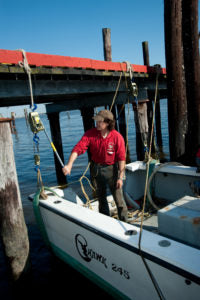Protecting Your Tools and Equipment From Rust

If you frequently work in or near corrosive environments, such as marine or industrial locations, you know that rust can make a job difficult in many ways. Tools can seize up or break, steel supports can degrade, and steel cables can break apart and snap.
Rust, or iron oxide, is the result of a chemical reaction between iron and oxygen. When oxygen in air or water reacts with the iron in steel, the rust that forms is less dense than the metal, which causes it to expand. As the rust expands and pushes the steel apart, it exposes more metal to the oxygen and the rusting process accelerates.
When steel tools or equipment are located near a body of saltwater, problems caused by rust can be multiplied dramatically. Salt increases the rate of reaction between iron and oxygen, so unprotected metal rusts quickly. Once rust starts, it can be difficult to stop, so the best approach is to take steps to prevent rust from forming in the first place.
How to Prevent Rust
There are many methods to keeping rust away from steel. One simple method commonly used on automobiles and large equipment is painting. When a metal surface is painted, the paint acts as a barrier between the iron in the steel and the oxygen in the air. However, if there is any unprotected steel that begins to rust, the rust can get between the paint and the metal and cause extensive damage.
Some more substantial methods of preventing rust that are often used for equipment located near saltwater are stainless steel and galvanization. These methods provide better protection to metal by making it virtually impossible for oxygen to come into contact with the iron.
Galvanized Steel
Galvanization works on a similar principal as painting; steel is coated in a layer of zinc, which does not rust. Like paint, the zinc galvanization protects the underlying steel from contact with oxygen and prevents rust from forming. Unlike paint, galvanization does not leave any unprotected surfaces where rust can begin to form.
The problem with galvanizations is that zinc can still oxidize, and it will eventually lose its effectiveness. Zinc oxidizes much more slowly than iron and steel, and it doesn’t damage tools and equipment the way rust does. However, the zinc will eventually corrode enough that the steel becomes exposed, and it can begin to rust after the galvanization is worn off.
Stainless Steel
Stainless steel is a great way to address the drawbacks of galvanization and painting. Unlike the other forms of rust protection, stainless steel does not coat steel with another material that doesn’t rust. Instead, high-quality stainless steel itself is invulnerable to rust because it also contains several other metals, including chromium.
Chromium provides one of the most important properties of stainless steel through its oxidation process. Unlike iron, which becomes fragile and falls apart when it rusts, chromium does not expand when it reacts with oxygen. Instead, the chromium on the surface reacts and forms a thin film of chromium oxide, which is neutral and non-reactive. The chromium oxide film does not flake and fall away, so the oxidation process stops. Because the entire volume of the steel contains the same amount of chromium, the film can repair itself by creating new chromium oxide if the surface is scratched or damaged.
Like galvanization, there are a few drawbacks to stainless steel. It is not as strong as standard carbon steel, and stainless steel cables can be 10%-15% weaker than standard cables. Stainless steel is also significantly more expensive than carbon steel or galvanization, so it’s more expensive up-front.
Protecting Your Tools
Rust can be one of the worst enemies for someone who works on or near saltwater, so it is especially important to protect metal tools in marine environments. There are a few precautions to take that improve protection against rust and corrosion. Tools and equipment should be stored indoors in a dry location to protect steel from moisture in the air.
It’s also important to clean and maintain any tools or equipment that are used in marine applications regularly. Cleaning equipment removes any accumulated dirt or salt that can cause rust to start and spread quickly. Applying grease and lubrication keeps moving parts working smoothly and protects them from water and oxygen to keep rust away.
Tools made from non-corrosive materials, such as aluminum, galvanized steel, or stainless steel, will increase the lifespan of equipment in marine applications. The Lug-All Marine Grade Come Along Ratchet Winch Hoist is built with an anodized aluminum alloy frame and a stainless steel cable to prevent it from rusting in saltwater environments. Using tools like the Lug-All Marine Grade Hoist, which are designed to resist corrosion, helps make sure they keep working as hard as you without ever worrying about rust.
